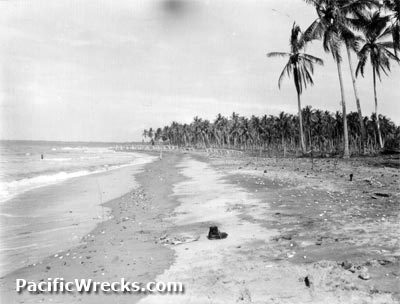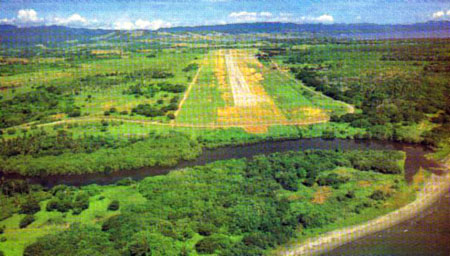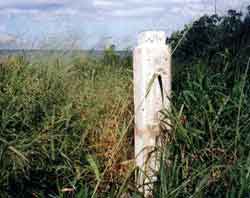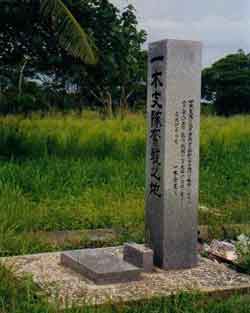|
|
|
|
| Missing In Action (MIA) | Prisoners Of War (POW) | Unexploded Ordnance (UXO) |
| Chronology | Locations | Aircraft | Ships | Submit Info | How You Can Help | Donate |
|
 USMC August 21, 1942    USMC August 22, 1942  U.S. Army March 23, 1943   Peter Flahavin 1996   Peter Flahavin 1999 |
Location On August 21, 1942 the Battle of the Tenaru was fought at Tenaru (Ilu, Alligator Creek) on the north coast of Guadalcanal. Also known as the "Battle of the Ilu River" or "The Battle of Alligator Creek". The battle was the first significant land battle of the Guadalcanal campaign between attacking Japanese Army 28th Infantry Regiment "Ichiki Regiment" versus the defending U.S. Marine Corps (USMC) 1st Marine Division (1st MarDiv), 1st Marine Regiment under the command of Colonel Clifton B. Cates. The result was a American victory and Japanese defeat. Background On August 19, 1942 Japanese destroyers landed the Japanese Army 28th Infantry Regiment "Ichiki Regiment" under the command of of Colonel Kiyonao Ichiki at Taivu Point and left a small rear echelon then began to advance westward toward Tenaru. Meanwhile, reports from Solomon Islanders including Jacob C. Vouza who escaped captivity reported to the Americans that the Japanese were to the east. To investigate, a patrol of sixty Marines with four native scouts under the command of Captain Charles H. Brush was sent eastward. Around noon at Koli Point, they clashed with a Japanese patrol of 38 soldiers from the Ichiki Regiment on a reconnaissance ahead of the main force. in the battle, three Marines were killed and three wounded but managed to kill most of the enemy patrol. Captured documents revealed details on the American positions in the Lunga Point perimeter. Only five Japanese survived and returned to Taivu Point. Although his reconnaissance patrol was defeated, Colonel Ichiki ordered the main body of his force to march overnight to the west. On August 20, 1942 by dawn the Japanese were several miles east of the Ilu River (Alligator Creek) and prepared for a night attack against the American perimeter. Meanwhile, on the west bank of the Ilu River (Alligator Creek) U.S. Marines from the 1st Marine Regiment under the command of Colonel Clifton B. Cates plus two 37mm anti-tank guns from the 1st Special Weapons Battalion rushed to prepare defensive positions on the west bank. The Marines were supported by divisional artillery including 75mm howitzers and 105mm howitzers that could fire on the eastern side of Alligator Creek and sandbar area. Battle of the Tenaru On August 21, 1942 after midnight, the Japanese reached the east bank of the Ilu River (Alligator Creek) and Marine listening posts heard voices and clanking and withdrew to the west bank. At 1:30am the first wave of the battle began when the Japanese opened fire with machine guns and mortars firing on the Marine positions on the west bank. Roughly 100 Japanese soldiers charged across the sandbar while the Marines repelled them with machine gun fire and 37mm canister rounds that killed most as they crossed the sandbar. A few of the Japanese soldiers managed to reach the Marine positions then engaged in hand to hand combat before capturing a few of the forward emplacements. A company of Marines, held in reserve counterattacked and killed most of the Japanese that had breached the defenses. Roughly an hour after it began, the first assault ended in defeat. At 2:30am the second wave of the battle began when roughly 150 to 200 Japanese made another attack across the sandbar at Hell's Point and were again almost entirely wiped out. At least one of the surviving Japanese Army officers from that survived the second wave attack advised Colonel Ichiki to withdraw his remaining forces, but he declined to do so. As Ichiki's remaining troops regrouped east of the creek, as Japanese mortars bombarded the Marine lines. The Marines responded with 75mm howitzer fire and mortar barrages into the areas east of the creek. At roughly 5:00am, the third wave of Japanese attacked attempting to flank the Marine positions by wading through the ocean surf and attacking up the beach into the west bank area of the creek bed. The Marines responded with heavy machine gun and artillery fire along the beach front area, again causing heavy casualties among Ichiki's attacking troops and causing them to abandon their attack and withdraw back to the east bank of the creek. For the next couple of hours, the two sides exchanged rifle, machine gun, and artillery fire at close range across the sandbar and creek. At daybreak, the 1st Battalion, 1st Marine Regiment under Lieutenant Colonel Lenard B. Cresswell crossed the Tenaru River upstream (south) of the battle area then enveloped Ichiki's troops from the south and east, cutting off any avenue for retreat, and began to "compress" Ichiki's troops into a small area in a coconut grove on the east bank of the creek. Meanwhile, U.S. aircraft from Henderson Field strafed Japanese soldiers that attempted to escape down the beach. Later in the afternoon, five U.S. Marine Corps M3 Stuart tanks from 1st Tank Battalion crossed the sandbar into the coconut grove firing their machine guns and 37mm canister shot and rolling over bodies, both alive and dead, of any Japanese soldiers unable or unwilling to get out of the way. When the tank attack ended, General Alexander A. Vandegrift wrote "the rear of the tanks looked like meat grinders. By 5:00pm, the battle ended with the Japanese defeated. After the battle, curious Marines explored the battlefield and some injured Japanese opened fire killing or wounding several Marines. Afterwards, Marines would routinely shoot or bayonet enemy bodies to ensure they were dead. Losses The Battle of the Tenaru was an American victory with just over forty killed. The Japanese were defeated with between 774 to 777 dead including Colonel Ichiki was reportedly killed by mortar fire. Fifteen Japanese that were injured or unconscious were captured and became Prisoners Of War (POW). Only about 30 Japanese managed to escape eastward and returned to report their defeat to the regiment's rear echelon at Taivu Point. Aftermath After the battle, the sandbar was covered with Japanese bodies partially buried by the rising tide. Photographs of the Japanese corpses documented their defeat in the first land battle of the Guadalcanal campaign. After the battle, the Marines continued to strengthen the eastern perimeter with concertina wire and a tank barrier. The Marines captured several intact Japanese small arms and weapons including a Type 92 heavy machine gun "Jukie", Type 99 light machine gun, Type 97 automatic cannon and Type 92 battalion gun. These weapons were later studied by intelligence and photographed. References Marines in World War II The Guadalcanal Campaign Chapter IV: Establishment of the Perimeter and Battle of the Tenaru pages 65-70 footnote 20 Helmet For My Pillow (1957) by Robert Leckie describes one Marine nicknamed "souvenirs" who was removing the gold teeth from fallen Japanese soldiers. Leckie himself writes about swimming across the river to steal a pair of binoculars from a dead body. Back ashore, he and his friends use the same binoculars to watch a large crocodile devouring the same corpse. You'll Be Sor-ree! (2010) by Sidney "Sid" Phillips "Lt. Pollack directed us to fire on an abandoned Marine amphibian tank on which the Japs had set up a machine gun on the other side of the river. We corrected range in a couple of rounds and then put one right in the tank. A loud cheer went up like a touchdown at a football stadium." Victory Fever on Guadalcanal (2014) by William Bartsch includes accounts of participants in the 2nd Battalion, 1st Marines (and also the 1st Battalion for the clean-up operation, with the tanks) and the 1st Special Weapons Battalion with their 37 mm anti-tank guns and machine guns Contribute
Information Last Updated
|
Map August 21, 1942 Photo Archive |
| Discussion Forum | Daily Updates | Reviews | Museums | Interviews & Oral Histories |
|